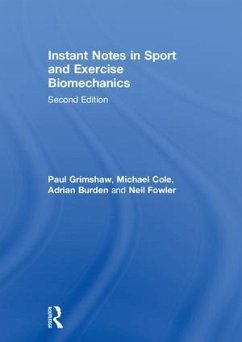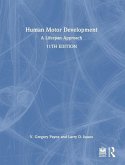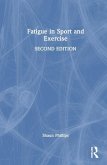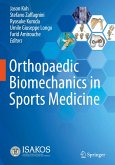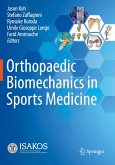- Gebundenes Buch
- Merkliste
- Auf die Merkliste
- Bewerten Bewerten
- Teilen
- Produkt teilen
- Produkterinnerung
- Produkterinnerung
Short thematic chapters make this textbook easy to read and navigate. With 15 new sections, it is full of applied examples, revision questions with solutions and definitions of key terms, and includes revision guides on essential maths and physics. The book also features a new companion website with testbank, slides and illustrations.
Andere Kunden interessierten sich auch für
![Human Motor Development Human Motor Development]() V. Gregory PayneHuman Motor Development215,99 €
V. Gregory PayneHuman Motor Development215,99 €![Fatigue in Sport and Exercise Fatigue in Sport and Exercise]() Shaun PhillipsFatigue in Sport and Exercise180,99 €
Shaun PhillipsFatigue in Sport and Exercise180,99 €![Orthopaedic Biomechanics in Sports Medicine Orthopaedic Biomechanics in Sports Medicine]() Orthopaedic Biomechanics in Sports Medicine119,99 €
Orthopaedic Biomechanics in Sports Medicine119,99 €![Data Analysis in Sport Data Analysis in Sport]() Peter O'DonoghueData Analysis in Sport210,99 €
Peter O'DonoghueData Analysis in Sport210,99 €![Orthopaedic Biomechanics in Sports Medicine Orthopaedic Biomechanics in Sports Medicine]() Orthopaedic Biomechanics in Sports Medicine90,99 €
Orthopaedic Biomechanics in Sports Medicine90,99 €![Philosophy and the Sciences of Exercise, Health and Sport Philosophy and the Sciences of Exercise, Health and Sport]() Mike McNamee (ed.)Philosophy and the Sciences of Exercise, Health and Sport196,99 €
Mike McNamee (ed.)Philosophy and the Sciences of Exercise, Health and Sport196,99 €![Seizure in children step by step management notes Seizure in children step by step management notes]() Neeraj JainSeizure in children step by step management notes51,99 €
Neeraj JainSeizure in children step by step management notes51,99 €-
-
-
Short thematic chapters make this textbook easy to read and navigate. With 15 new sections, it is full of applied examples, revision questions with solutions and definitions of key terms, and includes revision guides on essential maths and physics. The book also features a new companion website with testbank, slides and illustrations.
Produktdetails
- Produktdetails
- Verlag: Garland Science
- 2. Auflage
- Seitenzahl: 442
- Erscheinungstermin: 22. Januar 2019
- Englisch
- Abmessung: 250mm x 175mm x 28mm
- Gewicht: 937g
- ISBN-13: 9781138640238
- ISBN-10: 1138640239
- Artikelnr.: 52962424
- Herstellerkennzeichnung
- Libri GmbH
- Europaallee 1
- 36244 Bad Hersfeld
- gpsr@libri.de
- Verlag: Garland Science
- 2. Auflage
- Seitenzahl: 442
- Erscheinungstermin: 22. Januar 2019
- Englisch
- Abmessung: 250mm x 175mm x 28mm
- Gewicht: 937g
- ISBN-13: 9781138640238
- ISBN-10: 1138640239
- Artikelnr.: 52962424
- Herstellerkennzeichnung
- Libri GmbH
- Europaallee 1
- 36244 Bad Hersfeld
- gpsr@libri.de
Paul Grimshaw is Associate Professor in Sports Engineering within the School of Mechanical Engineering at the University of Adelaide, Australia, where he is also Director of Engagement and Bachelor of Engineering (Mechanical and Sports) Program Coordinator. His main research interests are concerned with the prevention of injury in the knee and lower back, especially in golf. Michael Cole is Senior Lecturer in Neuroscience and Motor Control within the School of Exercise Science at the Australian Catholic University, Australia. He has been involved in a number of multi-disciplinary research programs that focus on injury prevention and span the areas of sports biomechanics, clinical biomechanics and neuroscience. His particular areas of expertise are in the assessment of postural instability, gait disability and falls in people with Parkinson's disease and the evaluation of the invasive and non-invasive therapies for movement disorders. Adrian Burden is Reader in Sport and Exercise Biomechanics in the Department of Sport and Exercise Sciences at Manchester Metropolitan University, UK, and is a Senior Fellow of the Higher Education Academy. He has held workshops on surface electromyography on behalf of the British Association of Sport and Exercise Sciences, and his research interests lie in the application of electromyography in clinical, sport and exercise settings. Neil Fowler is Dean of Students at the University of Salford, UK. Before joining the University of Salford, Neil held the roles of Head of Exercise and Sport Science and Associate Dean of Learning Teaching and Quality Enhancement at Manchester Metropolitan University, UK. His research interests include spinal mechanics and pain management, the energetics of wheelchair propulsion and Paralympic sport, and the biomechanics of jumping.
Section A: Kinematics of Linear Motion
A1. Linear Motion
A2. Centre of Gravity and Centre of Mass
A3. Equilibrium
A4. Kinematic Data: Differentiation
A5. Kinematic Data: Integration
A6. Uniform Acceleration and Projectile Motion
Section B: Kinetics of Linear Motion
B1. Forces
B2. Gravity
Weight and Vertical Projection
B3. Friction
B4. Impulse and Momentum
B5. Conservation of Linear Momentum
B6. Newton's Laws of Motion: Linear Motion
Section C: Kinematics and Kinetics of Angular Motion
C1. Angular Motion
C2. Linear-Angular Motion
C3. Torque and Moments
C4. Levers
C5. Centripetal Force and Acceleration
C6. Moment of Inertia and Angular Momentum
C7. Newton's Laws of Motion: Angular Motion
Section D: Muscle and Joint Kinematics and Kinetics
D1. Muscle and Joint Forces: Statics and Dynamics
Section E: Special Topics
E1. Work
Power and Energy
E2. Conservation of Energy
E3. Mechanics of Materials
E4. Impacts
E5. Centre of Percussion
Section F: Human Movement Applications
F1. Walking
F2. Running
F3. Jumping
F4. Throwing
F5. Kicking
F6. Swimming
F7. Golf
Section G: Measurement and Analysis Techniques
G1. Optoelectronic Analysis
G2. Wearable Sensors
G3. Force Plate
G4. Pressure Measurement
G5. Electromyography
G6. Isokinetics
G7. Sports Equipment
G8. Data Smoothing
Filtering and Processing
Section H: Appendices
H1. Planes and Axes of Motion
H2. Free Body Diagrams
H3. Sampling Theory
H4. Biomechanics Apps (Applications)
H5. Foundations of Motion Analysis
H6. Mathematics: Algebra and Trigonometry
A1. Linear Motion
A2. Centre of Gravity and Centre of Mass
A3. Equilibrium
A4. Kinematic Data: Differentiation
A5. Kinematic Data: Integration
A6. Uniform Acceleration and Projectile Motion
Section B: Kinetics of Linear Motion
B1. Forces
B2. Gravity
Weight and Vertical Projection
B3. Friction
B4. Impulse and Momentum
B5. Conservation of Linear Momentum
B6. Newton's Laws of Motion: Linear Motion
Section C: Kinematics and Kinetics of Angular Motion
C1. Angular Motion
C2. Linear-Angular Motion
C3. Torque and Moments
C4. Levers
C5. Centripetal Force and Acceleration
C6. Moment of Inertia and Angular Momentum
C7. Newton's Laws of Motion: Angular Motion
Section D: Muscle and Joint Kinematics and Kinetics
D1. Muscle and Joint Forces: Statics and Dynamics
Section E: Special Topics
E1. Work
Power and Energy
E2. Conservation of Energy
E3. Mechanics of Materials
E4. Impacts
E5. Centre of Percussion
Section F: Human Movement Applications
F1. Walking
F2. Running
F3. Jumping
F4. Throwing
F5. Kicking
F6. Swimming
F7. Golf
Section G: Measurement and Analysis Techniques
G1. Optoelectronic Analysis
G2. Wearable Sensors
G3. Force Plate
G4. Pressure Measurement
G5. Electromyography
G6. Isokinetics
G7. Sports Equipment
G8. Data Smoothing
Filtering and Processing
Section H: Appendices
H1. Planes and Axes of Motion
H2. Free Body Diagrams
H3. Sampling Theory
H4. Biomechanics Apps (Applications)
H5. Foundations of Motion Analysis
H6. Mathematics: Algebra and Trigonometry
Section A: Kinematics of Linear Motion, A1. Linear Motion, A2. Centre of Gravity and Centre of Mass, A3. Equilibrium, A4. Kinematic Data: Differentiation, A5. Kinematic Data: Integration, A6. Uniform Acceleration and Projectile Motion, Section B: Kinetics of Linear Motion, B1. Forces, B2. Gravity, Weight and Vertical Projection, B3. Friction, B4. Impulse and Momentum, B5. Conservation of Linear Momentum, B6. Newton's Laws of Motion: Linear Motion, Section C: Kinematics and Kinetics of Angular Motion, C1. Angular Motion, C2. Linear-Angular Motion, C3. Torque and Moments, C4. Levers, C5. Centripetal Force and Acceleration, C6. Moment of Inertia and Angular Momentum, C7. Newton's Laws of Motion: Angular Motion, Section D: Muscle and Joint Kinematics and Kinetics, D1. Muscle and Joint Forces: Statics and Dynamics, Section E: Special Topics, E1. Work, Power and Energy, E2. Conservation of Energy, E3. Mechanics of Materials, E4. Impacts, E5. Centre of Percussion, Section F: Human Movement Applications, F1. Walking, F2. Running, F3. Jumping, F4. Throwing, F5. Kicking, F6. Swimming, F7. Golf, Section G: Measurement and Analysis Techniques, G1. Optoelectronic Analysis, G2. Wearable Sensors, G3. Force Plate, G4. Pressure Measurement, G5. Electromyography, G6. Isokinetics, G7. Sports Equipment, G8. Data Smoothing, Filtering and Processing, Section H: Appendices, H1. Planes and Axes of Motion, H2. Free Body Diagrams, H3. Sampling Theory, H4. Biomechanics Apps (Applications), H5. Foundations of Motion Analysis, H6. Mathematics: Algebra and Trigonometry
Section A: Kinematics of Linear Motion
A1. Linear Motion
A2. Centre of Gravity and Centre of Mass
A3. Equilibrium
A4. Kinematic Data: Differentiation
A5. Kinematic Data: Integration
A6. Uniform Acceleration and Projectile Motion
Section B: Kinetics of Linear Motion
B1. Forces
B2. Gravity
Weight and Vertical Projection
B3. Friction
B4. Impulse and Momentum
B5. Conservation of Linear Momentum
B6. Newton's Laws of Motion: Linear Motion
Section C: Kinematics and Kinetics of Angular Motion
C1. Angular Motion
C2. Linear-Angular Motion
C3. Torque and Moments
C4. Levers
C5. Centripetal Force and Acceleration
C6. Moment of Inertia and Angular Momentum
C7. Newton's Laws of Motion: Angular Motion
Section D: Muscle and Joint Kinematics and Kinetics
D1. Muscle and Joint Forces: Statics and Dynamics
Section E: Special Topics
E1. Work
Power and Energy
E2. Conservation of Energy
E3. Mechanics of Materials
E4. Impacts
E5. Centre of Percussion
Section F: Human Movement Applications
F1. Walking
F2. Running
F3. Jumping
F4. Throwing
F5. Kicking
F6. Swimming
F7. Golf
Section G: Measurement and Analysis Techniques
G1. Optoelectronic Analysis
G2. Wearable Sensors
G3. Force Plate
G4. Pressure Measurement
G5. Electromyography
G6. Isokinetics
G7. Sports Equipment
G8. Data Smoothing
Filtering and Processing
Section H: Appendices
H1. Planes and Axes of Motion
H2. Free Body Diagrams
H3. Sampling Theory
H4. Biomechanics Apps (Applications)
H5. Foundations of Motion Analysis
H6. Mathematics: Algebra and Trigonometry
A1. Linear Motion
A2. Centre of Gravity and Centre of Mass
A3. Equilibrium
A4. Kinematic Data: Differentiation
A5. Kinematic Data: Integration
A6. Uniform Acceleration and Projectile Motion
Section B: Kinetics of Linear Motion
B1. Forces
B2. Gravity
Weight and Vertical Projection
B3. Friction
B4. Impulse and Momentum
B5. Conservation of Linear Momentum
B6. Newton's Laws of Motion: Linear Motion
Section C: Kinematics and Kinetics of Angular Motion
C1. Angular Motion
C2. Linear-Angular Motion
C3. Torque and Moments
C4. Levers
C5. Centripetal Force and Acceleration
C6. Moment of Inertia and Angular Momentum
C7. Newton's Laws of Motion: Angular Motion
Section D: Muscle and Joint Kinematics and Kinetics
D1. Muscle and Joint Forces: Statics and Dynamics
Section E: Special Topics
E1. Work
Power and Energy
E2. Conservation of Energy
E3. Mechanics of Materials
E4. Impacts
E5. Centre of Percussion
Section F: Human Movement Applications
F1. Walking
F2. Running
F3. Jumping
F4. Throwing
F5. Kicking
F6. Swimming
F7. Golf
Section G: Measurement and Analysis Techniques
G1. Optoelectronic Analysis
G2. Wearable Sensors
G3. Force Plate
G4. Pressure Measurement
G5. Electromyography
G6. Isokinetics
G7. Sports Equipment
G8. Data Smoothing
Filtering and Processing
Section H: Appendices
H1. Planes and Axes of Motion
H2. Free Body Diagrams
H3. Sampling Theory
H4. Biomechanics Apps (Applications)
H5. Foundations of Motion Analysis
H6. Mathematics: Algebra and Trigonometry
Section A: Kinematics of Linear Motion, A1. Linear Motion, A2. Centre of Gravity and Centre of Mass, A3. Equilibrium, A4. Kinematic Data: Differentiation, A5. Kinematic Data: Integration, A6. Uniform Acceleration and Projectile Motion, Section B: Kinetics of Linear Motion, B1. Forces, B2. Gravity, Weight and Vertical Projection, B3. Friction, B4. Impulse and Momentum, B5. Conservation of Linear Momentum, B6. Newton's Laws of Motion: Linear Motion, Section C: Kinematics and Kinetics of Angular Motion, C1. Angular Motion, C2. Linear-Angular Motion, C3. Torque and Moments, C4. Levers, C5. Centripetal Force and Acceleration, C6. Moment of Inertia and Angular Momentum, C7. Newton's Laws of Motion: Angular Motion, Section D: Muscle and Joint Kinematics and Kinetics, D1. Muscle and Joint Forces: Statics and Dynamics, Section E: Special Topics, E1. Work, Power and Energy, E2. Conservation of Energy, E3. Mechanics of Materials, E4. Impacts, E5. Centre of Percussion, Section F: Human Movement Applications, F1. Walking, F2. Running, F3. Jumping, F4. Throwing, F5. Kicking, F6. Swimming, F7. Golf, Section G: Measurement and Analysis Techniques, G1. Optoelectronic Analysis, G2. Wearable Sensors, G3. Force Plate, G4. Pressure Measurement, G5. Electromyography, G6. Isokinetics, G7. Sports Equipment, G8. Data Smoothing, Filtering and Processing, Section H: Appendices, H1. Planes and Axes of Motion, H2. Free Body Diagrams, H3. Sampling Theory, H4. Biomechanics Apps (Applications), H5. Foundations of Motion Analysis, H6. Mathematics: Algebra and Trigonometry

